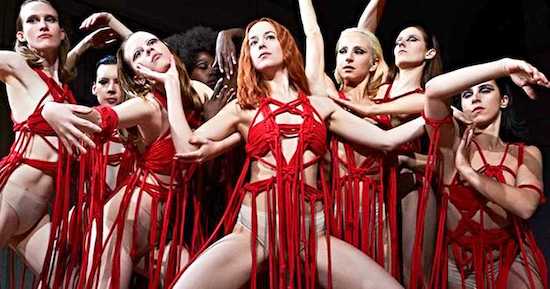There’s no denying Luca Guadagnino’s mastery of celluloid sensuality — if the title hadn’t already been claimed, a handful of films across his oeuvre could have aptly been called Cinema Paradiso. His exquisite use of light and texture has licensed him time and time again to have his cake and eat it; fashioning deeply humanist cinema with a carnal aesthetic flair. This technique is used to ruthless affect in Suspiria. Over and over again Guadagnino draws us in to his universe of velvet repulsion. Blood flows, bones crack and bodies drop, but Suspiria lacks the machismo priapism of its slasher roots, eschewing eroticism with callous glee.
That isn’t to say Guadagnino’s treatment of this cult property isn’t handled with the upmost respect and scalpel precision. The director throughly peels away the aestheticised cutis of the original, stripping substance from style. The bare bones of Argento’s narrative remain: a naive American, Susie Bannion, gets accepted into a prestigious dance school in Germany, which turns out to be run by a coven of witches. Guadagnino makes deliberate moves, treating the original’s narrative like sacred burial ground. There’s a painful awareness of the architecture Guadagnino carefully builds around the original. More concerned with the primitive tensions of womanhood than that of knife and bone, This is a film of signs and symbols in which David Kajganich’s little slip of a screenplay doubles as a guide rope into the allegorical thick of it.
Like the original, Suspiria opens with ex-student, Patricia (Chloe Grace-Moretz) fleeing the academy amidst torrential rain. Deeply paranoid, she seeks solace in her psychologist Dr. Josef Klemperer (Lutz Ebersdorf, read Tilda Swinton). Patricia, obsessed with the order of witches running the dance show, has filled her diary with endless ramblings and repetitive symbols. Deftly name checking Lacan and Jung as an immediate point of order, Dr. Klemperer tries to rationalise her delusions as symptomatic of a larger unchecked trauma (perhaps childhood?). For all its initial psychoanalytical preoccupations, Suspiria quickly canonises the witches in the realm of the real. Removing the central MacGuffin of the original, transforming it into its narrative tentpole. However, despite his occasional formal persnicketiness, Guadagnino displays a mastery of tonal consistency, managing to just about sustain a seemingly equable milieu whilst throwing more and more symbolic ideas on the bonfire.
Suspiria’s symbolic life force, a preternatural dance routine known as the Volk, becomes the gathering place for Guadagnino’s auxiliary ideas. A preternatural dance-routine, forged in a post WW2 Germany, there’s a suggestion the Volk represents the violence of movement, the tensions of Womanhood and something regarding the suffering of the Shoah. Whilst not all of it comes together in sharp relief, occasionally Guadagnino burns daylight searching for connective tissue, his anarchic entropy is intoxicating. In spite of this, the Volk as the physical manifestation of Guadagnino’s symbolic preoccupations is a marvel. Its disjointed throes an obsession of Susie’s (a nasty paper-cut of a performance from Dakota Johnson) long before her arrival, having seen the Volk being performed before her arrival. In an utterly rapturous scene, whilst dancing the Volk, Susie, aligning her violent feminine chakras is able to create and destroy in the same movement. This sequence, which uses lucid editing to inflict maximum damage achieves a moment of sublime, vulgar beauty. A bruising gut punch of a sequence is a vicious knockout, one that leaves you seeing stars.
It’s perhaps Sayombhu Mukdeeprom’s late-Rothko colour scheme that is the most noticeable departure from the original property. This approach, which sees Guadagnino trading candy for concrete, gives Suspiria its own, albeit not unique, aesthetic identity. Brick, by brick, Guadagnino constructs a stunning brutalist cathedral. Suspiria is as close as Guadagnino has ever ventured towards a period piece. Inspired by Fassbinder, the film manages to portray various states of personal disarray and mental paranoia. But the film’s not without its Argento-aestheticised passages: choice use of crash zooms, coloured filters and slow motion only add to the alienating horror of a movie occasionally feels like the world’s premiere dissociative episode. Thom Yorke’s lamenting witches’ brew of a score feels more like a personal exorcism than the viciously universal appeal of Goblin’s pulsating synth score. But above all of this, there’s an undeniable sense of morbid fun that Guadagnino is having inhibiting 1977 Berlin. Sometimes he’s mirroring the brutal realism that marked The New German Cinema, sometimes playing more into his showman tendencies — the result is something thats both specific and imagined.
To its devoted fans, Argento’s Suspiria isn’t so much a movie, but a space one inhabits. A baroque, neon splattered fun-house who’s illegibility became part of its familiarity. This might be what attracted Guadagnino in the first place. He’s always mastered the art of inhabiting beautiful spaces. This time, Guadagnino going beyond his usual sun-kissed beaches or pastoral country sides, to discover something stranger than paradise. Through symbolically duplicating Suspiria , Guadagnino allows it to develop an entirely new truth of its own, creating a violent work of abstract expressionism, one with gorgeous shifting interiors.
Suspiria is at UK cinemas now


